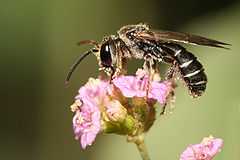Sweat bee

Sweat bee is the common name for any bees that are attracted to the salt in human sweat. In its strict application, the name refers to members of the Halictidae, a large family of bees that are common in most of the world except Australia and Southeast Asia, where they are only a minor faunistic element. In the United States, the common species are black, brown, red, or metallic green, and sometimes with yellow markings, and usually 1/4 to 1/2 inch (4–10 mm) in size. Their attraction to sweat makes them a nuisance, as they will sting if squeezed or squashed against one's flesh. Their sting is rated a 1.0 on the Schmidt Sting Pain Index, making it quite minor. Individuals with allergies to any kind of insect stings should seek immediate medical attention. Pest control is not recommended due to their beneficial nature in pollination.
As with many common names, however, the term "sweat bee" is also applied colloquially to other species of bees, despite its technical restriction to halictids. Thus, in Africa the colloquial name is sometimes used to refer to what are technically known as stingless bees of the family Apidae, which also have the habit of taking up salt from human perspiration. In parts of Southeast Asia the term is sometimes applied to species of Trigona. The European honey bee, Apis mellifera, also occasionally laps human perspiration, as will other bees on occasion.
See also
External links
- Everything About the Sweat Bee - Description and photo of the sweat bee
- sweat bees on the UF / IFAS Featured Creatures Web site